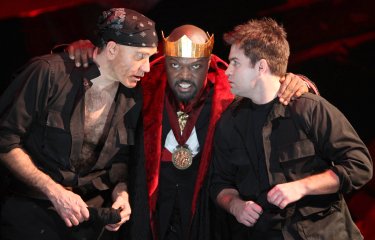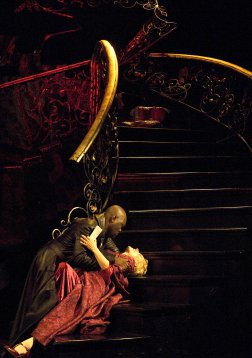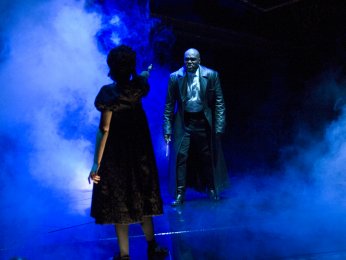Summary 
Modernized with striking visuals, but performed with the subtlety of a sledgehammer. Occasionally exceptional, sometimes quite good, but too often over-emoted and over-the-top in gesture. With some onstage restraint and a clearer focus - on time frame, the witches, and their prophesies - this could have been an outstanding production. As performed, this is an evocatively staged production that pleases the crowd as campy entertainment but disappoints as tragic drama.
Design
Directed by Gale Edwards. Set by Scott Bradley. Costumes by Murell Horton. Lights by Mark McCullough. Sound and original music by Todd Barton. Fights by U. Jonathan Toppo.
Cast
Peter Macon (Macbeth), Robin Goodrin Nordli (Lady Macbeth), Kevin Kenerly (Macduff), Rex Young (Banquo), Josiah Phillips (Porter/Doctor), Jeany Park (Lady Macduff), James Jesse Peck (Duncan/First Murderer), Jeremy Peter Johnson (Malcolm).
Analysis
Gale Edwards' modernized Macbeth, mounted on a stage that serves as both a body-strewn battlefield as well as a bombed-out castle interior, features an enormous upstage screen that glows crimson blood red at the beginning and changes to reflect the current scene. A gilded staircase, pock-marked with bullet holes, rises stage left and leads to an elevated platform that spans the width of the playing area upstage. Downstage is bordered with the images of a twisted mass of battlefield dead, limbs and torsos and faces emerging from a muddy morass in a ghastly nightmare like a burial pit. The victims appear as though the partially buried dead or the victims of a biological or nuclear attack. Twisted metal as well as charred and bullet-riddled concrete are visible upstage.
Although modernized, the soldiers carry only swords and knives, but gunfire is audible in the distance and when the traitorous Thane of Cawdor is executed offstage by firing squad. Military officers in Duncan's army wear trench coats and boots with caps or berets, and they give a Roman-style double thump of the chest as a greeting salute. The witches, aged and gray-haired and with blackened eyes, lurk in candle light, stage fog billowing from three traps even as the house lights remain up. The lights drop in a dramatic blackout as action-movie music suddenly blares and several skirmishes spill onto the stage. The muscular and vehement Macbeth, a bloody gash across one cheek, emerges victorious, and he struts and howls. The witches appear unimpressed with his victory, then bored with the recounting of his exploits to the tall and commanding King Duncan.

Peter Macon's manic Macbeth seems to channel Hollywood movie star Samuel L. Jackson with his stern-eyed glares and deep booming commands. Bald, goateed, and muscular, Macon's Macbeth is a formidable stage presence, and he reveals emotion with broad physical gestures: when Malcolm is named Duncan's heir, Macon's Macbeth smiles and laughs, but then glowers and grumbles when no one is looking; he laughs gaily as his guests retire for the evening, but shoots a vicious glare at Fleance; he makes the stout-hearted Lady Macbeth flinch and cringe with just a frown; and his expression of grief after her suicide ("she should have died hereafter") is a disoriented afterthought.
Macon's dominating physical presence can make for powerful theatre - he smears Malcolm's face with blood to show him the danger he is in after Duncan is murdered, he leaps atop the banquet table to confront the bloody ghost of Banquo, and he spits at the prospect of surrender before the climactic duel with MacDuff - but too often his speech is shouted and his movements exaggerated. When first confronted by the prophesies of the witches, Macon's Macbeth stomps his feet, wheels and exclaims, then turns and starts to runs away at the prospect of being King. At the Lady's mention of regicide, Macon's Macbeth literally leaps backward away from her, and much later, after his demands to be "alone" and away from his Lady, Macon's Macbeth quickly becomes isolated and insane, and he rapidly blinks his eyes, looks in every direction, and moves in dramatic starts and exaggerated jumps. The exaggerated emotion enthralls much of the audience, and Lady Macbeth behaves with the same overstated histrionics, but the overall effect is campy entertainment rather than dramatic tragedy.

Robin Goodrin Nordli's bejeweled Lady first appears spot lit on the ramp in a sparkly cranberry-colored gown, her blonde hair down around her shoulders. Her "unsex me here" soliloquy is delivered with chilling strength from the downstage glare of a footlight, her enormous shadow looming creepily against the upstage screen. When Macon's Macbeth arrives, he lifts her, nuzzles her breast, and carries her to the stairs, where they grapple in heated passion. More than a trophy, Nordli's wily Lady reveals lofty ambitions, and she manipulates her husband with the promise of intimacy, and later, when he wavers even with Duncan a guest within his household, she grows angry with him and becomes physical, seducing him with a combination of sex and violence. Macon's Macbeth capitulates, completely seduced, and he seems to devour her words, even dancing with her as she plots the royal bloodletting. Nordli's maniacal laugh at the notion they may fail, reminiscent of a cartoon villainess, draws a laugh from the audience. After the offstage murder - effectively denoted only by a piercing shriek from an owl - Macbeth staggers down the ramp, his white shirt covered with blood, and she helps him, but they both cry out and jump with the onset of the amplified off-stage knocking. The most effective acting by either Macon or Nordli is the subtle changes in their characters: with the hiring of the murderers to kill Banquo and Fleance, Macon's Macbeth realizes he has gone too far and so continues descending into evil without looking back (and without the Lady at his side), just as Nordli's Lady, despite her initial bloodlust and cold-hearted purpose, becomes horrified and shaken at their deeds.

Macon and Nordli are mercurial in their performances, both rising to scenes of stunning power but both teetering near the ludicrous on other occasions. Edwards' witches are more effectively played, if less powerfully wrought. The three old hags encircle Macbeth but disappear from him one by one as he implores them for further details. Later, during the dagger hallucination, the aged witches are replaced with young girls - unexplained, but perhaps the witches of the Lady, furthering the sense of seduction and emphasizing the lust for power - and they dangle their knives before him, slinking backward when Macbeth reaches out to them, until Macon's Macbeth finally draws his own lethal-looking dagger. When the Lady appears on the ramp for her sleepwalking scene, she is closely followed by the three young witches, who behave like attendants of her own personal haunting. For the earlier banquet scene, the doubled sets of witches carry in the long banquet table, three young witches at one end, three old witches at the other. Murmurs of confusion ripple through the audience at who the women were intended to represent. After the intermission, the three older witches appear on the long ramp above to watch more of the defections from Macbeth, and a boiling cauldron emerges from a center stage trap in orange light. The witches spring upon Macbeth to force him to drink, stripping off his shirt and placing a voodoo necklace around his bared neck, and they leave white powder hand prints where they touch him. In another surreal moment that brings titters of laughter, the witchcraft prophesies emerge from the cauldron as giant-headed baby puppets that lurch and wobble across the stage. The weakly-staged sequence has audience members shaking their heads, but moments later, after the three witches force Macbeth face-first into pool and nearly drown him, Edwards saves the scene with a memorably eerie image: as a gasping, nearly drowned Macbeth struggles to look, a series of faceless black-clad ghosts - all wearing royal crowns - appear on the ramp, then move down toward Macbeth in a taunting procession, the last carrying a gilded mirror.
Edwards' infuses Macbeth with a series of strong scenes: the drunken Duncan staggers up the ramp to three cheers of "Scotland!" and his eventual murder, the backlit screen fairly throbbing with crimson; the third murderer, Seyton, slits Banquo's throat in a graphic arterial spray; and the bloodied and shoeless Banquo appears at Macbeth's place at the head of the banquet table. But as seems definitive of this production, other scenes stumble with overkill or cause unintended laughter: the Asian Lady Macduff and her braided daughter both wear silky kimono robes, and after they are stabbed they are splashed with gasoline from a can by one murderer as another flicks open a butane lighter; Macduff backpedals so dramatically at the news of his family's demise that he seems about to propel himself off the stage; the movement of Birnam Wood is depicted with soldiers using long neon-green stick-flashlights to lighten their way; and when Macduff dispatches him, Macbeth is quickly surrounded, and his blank-eyed plastic severed head is then displayed upon the sword to Malcolm's applause. These weaker moments may be outweighed by Edwards' powerful scenes, but the overall effect is somewhat disappointing. And in the now-typical Macbeth conclusion, the old witches gather around Donalbain as he jealously stares at the newly crowned Malcolm, the circularity of the evil of ambition quite apparent.